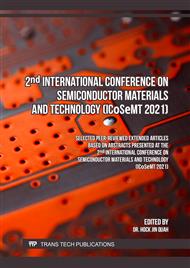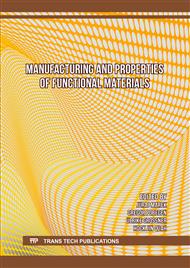[1]
G. Taylor, Disintegration of water drops in an electric field, Proceedings of the Royal Society of London. Series A. Mathematical and Physical Sciences. 280 (1964) 383-397.
DOI: 10.1098/rspa.1964.0151
Google Scholar
[2]
P. Mehta, H-A. Ria, M. Rasekh, M.S. Arshad, A. Smith, S.M.V.D. Merwe, X. Li, M. W. Chang, Z. Ahmad, Pharmaceutical and biomaterial engineering via electrohydrodynamic atomization technologies, Drug Discovery Today. 22 (2017) 157-165.
DOI: 10.1016/j.drudis.2016.09.021
Google Scholar
[3]
J. Xue, T. Wu, Y. Xia, Electrospinning and Electrospun Nanofibers: Methods, Materials, and Applications, Chem. Rev. 119 (2019) 5298-5415.
DOI: 10.1021/acs.chemrev.8b00593
Google Scholar
[4]
A. Haider, S. Haider, I Kang, A comprehensive review summarizing the effect of electrospinning parameters and potential applications of nanofibers in biomedical and biotechnology, Arabian Journal of Chemistry. 11 (2018) 1165-1188.
DOI: 10.1016/j.arabjc.2015.11.015
Google Scholar
[5]
D. Han, A. Steckl, Coaxial Electrospinning Formation of Complex Polymer Fibers and their Applications, Chem. Europe. 84 (2019) 1453-497.
DOI: 10.1002/cplu.201900281
Google Scholar
[6]
Y. Zhang, T. R. Nayak, H. Hong, W. Cai, Biomedical applications of zinc oxide nanomaterials. Current Molecular Medicine. 13 (2013) 1633-1645.
DOI: 10.2174/1566524013666131111130058
Google Scholar
[7]
E. Ferrone, R. Araneo, A. Notargiacomo, M. Pea, A. Rinaldi, ZnO Nanostructures and Electrospun ZnO – Polymeric Hybrid Nanomaterials in Biomedical, Health, and Sustainability Applications, Nanomaterials. 9 (2019) 1449.
DOI: 10.3390/nano9101449
Google Scholar
[8]
A. Luraghi, F. Peri, L. Moroni, Electrospinning for drug delivery applications: A review, Journal of Controlled Release. 334 (2021) 463-484.
DOI: 10.1016/j.jconrel.2021.03.033
Google Scholar
[9]
Y. Bagbi, A. Pandey, P.R. Solanki, Chapter 10 - Electrospun Nanofibrous Filtration Membranes for Heavy Metals and Dye Removal, Nanoscale Materials in Water Purification. (2019) 275-288.
DOI: 10.1016/b978-0-12-813926-4.00015-x
Google Scholar
[10]
M.L. A. Anero, A. D. S. Montallana, M. R. Vasquez Jr, Fabrication of electrospun poly(vinyl alcohol) nanofibers loaded with zinc oxide particles, Results in Physics. 25 (2021) 104223.
DOI: 10.1016/j.rinp.2021.104223
Google Scholar
[11]
R.M. Nezarati, E. Cosgriff-Hernandez, Effects of Humidity and Solution Viscosity on Electrospun Fiber Morphology, Tissue Eng Part C Methods. 19 (2013) 810-819.
DOI: 10.1089/ten.tec.2012.0671
Google Scholar
[12]
M. Song, K. Kartawira, K. D. Hillaire, C. Li, C.B. Eaker, A. Kiani, K. E. Daniels, Overcoming Rayleigh–Plateau instabilities: Stabilizing and destabilizing liquid-metal streams via electrochemical oxidation, Proceedings of the National Academy of Sciences of the United States of America. 117 (2020) 19026-19032.
DOI: 10.1073/pnas.2006122117
Google Scholar
[13]
H. Fong, I. Chun, D.H. Reneker, Beaded nanofibers formed during electrospinning, Polymer. 40 (1999) 4585-4592.
DOI: 10.1016/s0032-3861(99)00068-3
Google Scholar
[14]
Y.M. Shin, M.M. Hohman, M.P. Brenner, G.C. Rutledge, Experimental characterization of electrospinning: the electrically forced jet and instabilities, Polymer. 42 (2001) 9955-9967.
DOI: 10.1016/s0032-3861(01)00540-7
Google Scholar
[15]
A.L. Yarin, S. Koombhongse, D. H. Reneker, Taylor cone and jetting from liquid droplets in electrospinning of nanofibers Taylor cone and jetting from liquid droplets in electrospinning of nanofibers, Journal of Applied Physics. 90 (2001) 4836.
DOI: 10.1063/1.1408260
Google Scholar
[16]
S. Zargham, S. Bazgir, A. Tavakoli, A.S. Rashidi, R. Damerchely, The Effect of Flow Rate on Morphology and Deposition Area of Electrospun Nylon 6 Nanofiber, Journal of Engineered Fibers and Fabrics. 7 (2021) 42-49.
DOI: 10.1177/155892501200700414
Google Scholar
[17]
A.S. Motamedi, M. Hamid, F. Hajiesmaeilbaigi, Effect of electrospinning parameters on morphological properties of PVDF nanofibrous scaffolds, Progress in Biomaterials. 6 (2017) 113-123.
DOI: 10.1007/s40204-017-0071-0
Google Scholar



